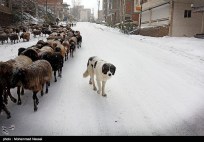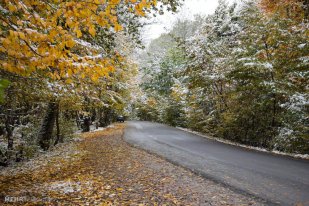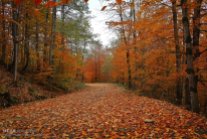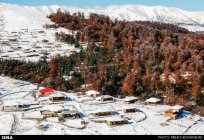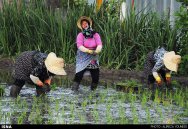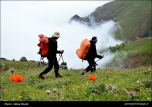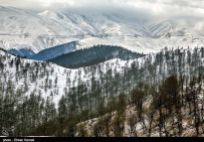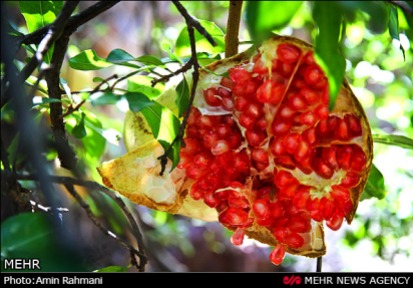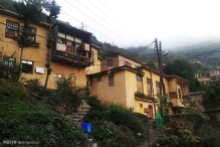Sources: IRNA 1, IRNA 2, ISNA 1, ISNA 2, ISNA 3, ISNA 4, Mehr News Agency (MNA 1), MNA 2, MNA 3, MNA 4, MNA 5, MNA 6, Tasnim News Agency (TNA) 1, TNA 2, TNA 3, TNA 4, TNA 5, Young Journalists Club
Tag Archives: Gilan Province
Photo Series: Autumn in Iran – Gilan Province
Gilan Province lies along the Caspian Sea, bordering the Republic of Azerbaijan in the north, as well as Russia across the Caspian Sea. The climate is humid subtropical with the heaviest rainfall in Iran. Rasht, the capital of the province, is known within Iran as the “City of Rain”.
Large parts of the province are mountainous, green and forested. The coastal plain along the Caspian Sea is similar to that of Mazandaran, mainly used for rice paddies.
In May 1990 large parts of the province were destroyed by a huge earthquake, in which about 45,000 people died. Abbas Kiarostami made his films Life, and Nothing More… and Through the Olive Trees based upon this event.
Enjoy Gilan’s beauty in autumn:
Photo Series: Autumn in Iran – Asalem to Khalkhal road
Khalkhal is the capital of Khalkhal County, in Ardabil Province, Iran. Its population is 38.521 (2006). Asalem is a city in Talesh County, Gilan Province, Iran. Its population is 3.347 (2006).
The road from Asalem to Khalkhal is known for its beautiful landscapes.
Sources: Wikipedia | Asalem, Wikipedia | Khalkhal, Tasnim News Agency, Mehr News, JameJam
Photo Series: Autumn in Iran – Snowfall in Masal, Gilan
Masal, a county in the western part of Gilan Province, encompases the upper valley of the Shanderman River and the whole catchment basin of the Masal River (also called Ḵālekāi) until its arrival into the plain. The local population, 48,000 inhabitants in 2006, speaks Talysh, Gilaki and Persian. Masal and Bazar Jomeh are the only cities in the county.
The main agricultural production is rice, cultivated in the lower valleys and the edge of the plain, in small holdings. Of the three usual complementary resources of the plain (namely sericulture, tobacco, and tea), sericulture is the only one to have had a significant but highly variable role. The impact on this area of the crisis of silk production in the late 2000’s is uncertain. The other main activity and source of income is stock-breeding.
Unlike the valleys adjacent to the north or to the south, this area has no temporary bazaars on summer pastures because of the strong attraction and relative proximity of the Friday bazaar in Shanderman and Saturday bazaar in Masal. In both cases, this commercial activity has launched an urbanization process by gradually gathering services and resident population around the commercial core.
Sources: JameJamOnline, Instagram, Wikipedia | Masal County, Enciclopædia Iranica | Masal
Photo Series: Autumn in Iran – Snowfall in Talesh, Gilan
Talesh is a 200,000 inhabitants county in Gilan Province, Iran. Its capital, Hashtpar (also called Talesh), is situated 140 km north-west of Rasht, on the south-west coast of the Caspian Sea. The region, a mountainous area, outstands with its virgin ant intact nature.
Photos of the first snowfall in Talesh:
The Talysh are one of the oldest inhabitants of the western littoral Caspian Sea and are amongst the native inhabitants of today Iran and neighboring Azerbaijan.
Generally speaking, the land of Talesh has been divided in three regions: Gaskarat, Foumanat and Azerbaijan Taloshian. In Gaskarat, the majority of people speak Taleshi and/or Azeri, Farsi. In Foumanat, most speak Taleshi. Lastly, Talysh from neighboring Azerbaijan are often bilingual and trillingual, consisting of Taleshi, Azeri and Russian speakers. Taleshian people at present are mostly Sunni and Shia Muslims.
Sources: ISNA, Wikipedia | Talesh County
Beautiful landscapes on the road from Pounel to Khalkhal (Photos)
Pounel (Poonel or Punel) is a village of 2,300 inhabitants in Rezvanshahr County, Gilan Province, Iran. Khalkhal lies in the eastern part of the historical Azerbaijan plateau and with a population of 38,521 (2006), is the capital of Khalkhal County, in Ardabil Province.
The main ethnic groups living in Khalkhal are Azeris (95%), followed by Talishs and Tats (3%), Kurds (1%) and Persians (1%).
The road from Pounel to Khalkhal has wonderful sights that can be enjoyed by car. If you like hiking, you can visit Ardeh, a village thirty kilometers from Pounel, with beautiful hiking trails.
Sources: IRNA, Instagram, Panoramio | Alireza Jahaveri, Panoramio | Ali Memari, Panoramio | Peyman Azimi, Wikipedia | Punel, Wkipedia | Khalkhal, Iran Travel Information Forum
Rice fields in Iran (Photos)
Iran is a vast country, covering 1,648,000 km2 (164.8 million ha). Its topography is dominated by two mountain ranges – Alborz and Zagros – while two great deserts extend over much of the central region, leaving about 20 million ha for crop production. On account of the highly diverse climatic and soil conditions, only 12.5 million ha are cultivated annually with a wide range of food crops. Wheat, rice and barley are the most important cereals cultivated.
Rice is the staple food in Iran, with the quality of cooked rice outweighing all other considerations for Iranian consumers. The total area under rice is more than 600 thousand ha and rice is now grown in varying degrees in nearly all provinces of Iran. However, more than 80 percent of rice area is distributed in the two northern provinces of Mazandaran and Gilan.







Iran’s rice production in 2011 was 2.4 million tons, which increased from a total of 2.3 million tons in the previous year. Iran has 3,800 rice milling units (2009). Iran has imported about 1.4 million tons of rice from UAE, Pakistan and Uruguay worth $800 million in 2009. Iran’s rice imports drop by 40% in 2010. The average per capita consumption of rice in Iran is 45.5 kg, which makes Iranians the 13th biggest rice consumers.
The photos were taken in different Iranian provinces: Qazvin, Gilan, Kurdistan, North Khorasan, Fars and Kohgiluyeh and Boyer-Ahmad.
Sources: Food and Agriculture Organization of the United Nations (FAO) | The rice situation in Iran by N. Shobha Rani, Wikipedia | Agriculture in Iran, Encyclopaedia Iranica | Berenj “rice”, Mehr News Agency | Photos, MNA | Photos, Tasnim News Agency | Photos 1, Tasnim | Photos 2, Tasnim | Photos 3, Tasnim | Photos 4, IRNA | Photos, ISNA | Photos 1, ISNA | Photos 2
Photos: Eshkevarat in Gilan and Mazandaran Provinces, Iran
Eskevarat is a region on the Alborz that extends through Gilan and Mazandaran Provinces.
The rural district (dehestan) Eshkevar-e Sofla lies in Rudsar County, Gilan Province. It has 46 villages and a population of 4,842 inhabitants (2006). Eshkevar is the name of a rural district with 11 villages in Ramsar County, Mazandaran Province. At the 2006 census, its population was 1,600.
Sources: Mehr News Agency | Photos 1, Mehr News Agency | Photos 2, Tishineh | Eshkevarat (Persian), Wikipedia | Eshkevarat (Persian), Wikipedia | Eshkevar-e Sofla, Wikipedia | Eshkevar
Photos: Hiking in Iran – From Lake Neor to Soobatan
Lake Neor, at an altitude of 2,700 meters above sea level, is located 48 km southeast of the city of Ardabil, Ardabil Province. The village of Soobatan, at 1,950 mamsl, is located 32km northwest of the city of Talesh, Gilan Province. The region is known for its breathtaking landscape.
Sources: Jamejam Online | Images (Photos: A. Niyati), Payvand News of Iran, Dream of Iran
Photo Series: Winter in Iran – Masuleh, Gilan Province
Beautiful pictures of Masuleh covered in snow:
For more detailed information about Masuleh and its unique architecture:
The other Iran | Iran’s Gilan Province: Masuleh Village
Source: Mehr News Agency | Photos
Photo gallery: Winter in Iran – Khalkhal-Asalem region
Khalkhal, with a population of 38,521 (2006), is the capital of Khalkhal County, in Ardabil Province, Iran. Asalem is a city in Talesh County, Gilan Province, Iran. Its population is 3,347 (2006). The road from Asalem to Khalkhal is known for its beautiful landscapes. This region, not far from the Caspian Sea, attracts many visitors every year.
Tasnim News Agency on December 26 dedicated its Iran’s Beauties in Photos section to pictures from winter in the northern part of Iran. Take a look:
Sources: Wikipedia | Asalem, Wikipedia | Khalkhal, Iran Front Page
Iran’s Gilan Province: Anbu – Pomegranate Harvest
Anbu (also known as Anbuh-e Mashayekh) is a village in Talesh County, Gilan Province, Iran. At the 2006 census it had a population of 385 inhabitants.
Citizens of Anbu, a village in the south of Gilan, harvest pomegranates as fall arrives.
Iran’s Gilan Province: Masuleh Village
Masuleh is a village in Gilan Province, Iran, founded in the 10th century AD. Historical names for the city include Masalar and Khortab. It has 554 inhabitants (as of 2006). The native people of Masuleh speak Talysh.
Masuleh is near the southern coast of the Caspian Sea, approximately 60km southwest of Rasht and 32km west of Fuman. It is 1.050m above sea level in the Alborz (or Elburz), surrounded by forest from valley to mount. The village itself has a difference in elevation of 100 meters. Fog is the predominant weather feature.
Masouheh-Rood-Khan is the river passing through the city, with a waterfall located just 200 meters away from the village. Many other springs are found nearby.
The architecture in Masuleh is unique. The buildings have been built into the mountain and are interconnected. Courtyards and roofs both serve as pedestrian areas similar to streets. Masuleh does not allow any motor vehicles to enter, due to its unique layout popularly known as “the yard of the building above is the roof of the building below”.
Yellow clay coats the exterior of most buildings in Masuleh. This allows for better visibility in the fog. Buildings are mostly two stories (1st floor and ‘ground’ floor) made of adobe, rods and bole. A small living room, big guest room, winter room, hall, WC and balcony are usually found in 1st floor. A cold closet, barn and stable are located on the floor below, which are connected to the upper floor by several narrow steps inside the building.
Although it has been written that the community was established around 10 AD, the first village of Masuleh was established around 1006 AD, 6 km northwest of the current city, and it is called Old-Masuleh (Kohneh Masuleh in Persian). People moved from Old-Masuleh to the current city because of pestilence and attacks from neighbouring communities.
There are four main local communities at the city named: “Maza-var” (meaning beside the Mosque) at the south, “Khana-var” (beside homes) at the East, “Kasha-sar” (stretched on top) at the North, and, “Assa-mahala” (Assad community) at the West. Apparently, down town is the Market (Bazaar) area and also the main mosque of the city built in 969 AD.
Sources: Wikipedia | Masuleh, Wikicommons | Masouleh, Mehr News | Photos, IRNA | Photos
Iran’s Gilan Province: Rice harvest 2014
Here some beautiful pictures of this year’s rice harvest in the Iranian Province of Gilan. (Click on an image to start the photo gallery):
Source: IRNA | Photos
Iran’s Gilan Province: Roudkhan Castle
The medieval Rudkhan Castle (Ghale Roodkhan) is located 25km southwest of the city of Fooman in Iran’s Gilan Province in the heart of the forest. Made from brick and stone, the castle covers 50,000 square meters and is 900 meters above sea level. Its architects have benefited from natural mountainous features in the construction of the fort. It is built on two tips of a mount with a total of 65 towers surrounding it, while the walls run 1,500 meters in length. 42 towers still stand intact. It is a military complex which had been constructed during the Seljuk Dynasty by followers of the Ismaili sect. The castle sits at the two peaks of a mountain at elevations of 715meters and 670meters, with an area of 2.6 hectares (6.4 acres). The Rudkhan Castle River originates in the surrounding heights and flows from south to north. It takes around two hours to cross a mountainous winding route with dense forests. To reach this castle people walk a three kilometer distance on foot, then climb around 2,000 steps. The first thing that one notices about the castle is its big entrance gate.
Sources: Wikipedia | Rudkhan Castle, Wikimedia Commons’ media related to Rudkhan Castle, wiseitinerary.blogspot.de, Mehr News Agency | Photos, Press TV
Iran’s Gilan Province: Photos (Part 1)
More photos of Iran: http://comeseeiran.tumblr.com/
Photos: Lahijan, in Gilan Province of Iran near the Caspian Sea
Info about Lahijan: Wikipedia | Lahijan
Talesh in province Gilan
Photos: Heavy Snow in Rasht, Northern Iran
First snow of the winter season gave a white cover to the caspian coast city of Rasht in northern Iran on Saturday. Rasht is the capital of Gilan Province and the largest city on Iran’s Caspian Sea coast with a population of 551,161 (2006 census). Rasht is a major trade center between Caucasia, Russia and Iran using the port of Bandar-e Anzali. Rasht is also a major tourist center with the resort of Masouleh in the adjacent mountains and the beaches of Caspian as some of the major attractions.
Gilan has a humid Subtropical climate with plenty of annual rainfall, while Rasht is known internationally as the “City of Silver Rains” and within Iran as the “City of Rain”. The Alborz range provides further diversity to the land in addition to the Caspian coasts. Despite of the abundant humidity, Gilan is known for its moderate, mild and Mediterranean-like climate.
More photos: Payvand News of Iran
The Caspian Sea, the worlds largest landlocked lake
“Caspian Sea, the largest landlocked lake in the world, is located in northern Iran. The Iranian Caspian coast including the three littoral provinces of Gilan, Golestan and Mazandaran, with its thick forests and large-scale rice paddies presents a striking contrast to the dry inner plateau of Iran.
A four-hour drive from Tehran, the Caspian is Iran’s Riviera, with a narrow plain of paddyfields and orchards separating the sea from forested mountains where bears and leopards roam around ruined Mongol castles.”
Also: Wikipedia | Caspian Sea



















